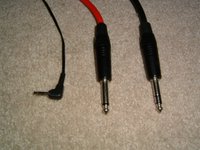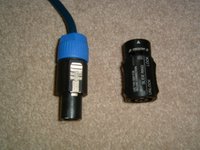Sound Reinforcement systems can be made up of many parts, which all need connecting. This can mean a cable or a wireless connection.
I will cover the different types of cable, and radio connections later, so this article is going to cover the most common connectors themselves and their different uses.
Before we look at those though, I want to mention the different types of signal that will be flowing through these connectors. I'm going to look at the most common analogue and digital signal connectors here, as more and more churches are using laptops, DVD players and projectors. I'm going to gloss over power connectors (such as CEEFORM) and lighting connectors (such as SOCAPEX) as we'll be looking in some detail at audio and digital signals, and I don't want to get bogged down with issues such as power handling and 3 Phase power. I'll give a guide as to the typical voltage you can expect on each level to give an idea of how they compare, though these are estimations, and within each type you can get transients that will peak much higher than these. Also we refer to these signal levels in a scale called Decibels (dB) so the figures are just for guidance.
Signal Types
- Mic Level - Typically 0.5 volts
- Line Level- Typically 1-1.5 volts
- Power Amp Output - Variable from 1-over 100 volts (enough to be dangerous!)
- Digital Signal (such as VGA output) less than 1 volt (levels are critical on digital signal, as anything over 0 dB is total distortion in digital world!)
Balanced & Unbalanced
I will expand on this idea further in another article, but with reference to connectors an unbalanced connector only requires two contacts (pins, cores etc) whereas a balanced one requires three. This is helpful when you need a quick way to identify whether a cable (eg jack) is balanced or not. NB Just because a connectors has several pins, does not mean that they are all connected!
Male & Female
Connectors are usually referred to as either male or female. Simply put, this describes the way the contact pins fit together in most cases. For touchproof connectors it refers to the way body of the connector and socket fit together. Suffice to say that Male's project (plug,) and Female's receive (socket.)Name: XLR - aka Cannon, Cannon Jack, 3 Pin Thingy
Signal Types: Mic, Power Amp & Digital (DMX lighting control)
Uses: Mostly used for microphone connections, also used for DI outputs, older power amp outputs and speaker connections (leading to power amp outputs being plugged in to mixer inputs and expensive repair bills!)
Description: A circular 3 pin connector where pin 1 = ground (X) pin 2 = +ve (L) and pin 3 = -ve (R) Can be used to convert a balanced signal to unbalanced by shorting pins 1 & 3 together.
Variations: Either anodized silver or grey, some manufacturers also supply coloured 'boots' to help with cable ID. Usually requiring soilder joints, Neutric do a range of push fit 'bodge' versions. Can be semi-waterproof (splashproof.) right-angled versions are available. Locking versions also available (ideal for singers who want to spin their mics around on the end of their leads; I have been there, but it' quite another story!)
Name: Jack - aka Stereo jack, mono jack, balanced jack, TRS jack, patch jack, guitar jack, headphone jack 1/4 Jack
Signal Types: Mic (unbalanced,) Line and Power Amp
Uses:Everything under the sun! From Power amp out puts/speaker connections to guitar cables, and from In Ear Headphones to MP3 and Laptop Outputs. Also used for 'inserting signals' in the signal path, where the signal is sent via the tip, and returned back to the same point, post-processing, via the ring (using a common ground connection)
Description: A slim, circular connector that runs it's 2 or 3 (or 4!) poles co-axially along its length, connecting at various points, giving the appearance of rings along it's length. Soldered connections. Available in various qualities and made from both metal or metal and plastic. The poles are called Tip, Ring and Shield.
Variations: There are three sizes; 2.5mm, 3.5mm and 6.35mm and 2 and 3 pole versions (4 pole versions are used in telecommunications, such as handsfree kits for mobile phones, but rarely in Sound Reinforcement.) All sizes available in right-angled.
Name: Phono - aka RCA Jack
Signal Type: Line, Digital (also used for a form of Line Level from record players, which is quite low level and requires RIAA preamps to raise it to standard line level.)
Uses: Standard players such as CD and DVD. Record players, DJ mixers and DJ effects. Video players and some video cameras. Projectors.
Description: Small circular connector with a projecting central pin (+ve) and an outer shield (ground) Quality ranges from very cheap to very good.
Variations: Other than quality, there are no major variations, though when used for SP/DIF a cable with a particular impedance is required. Note the 'Pro-fi' versions on the right in the picture have a sprung shield, which means the ground connection makes contact first when plugging the connectors into a socket. This should mean that there are no noises created when connecting or disconnecting the connector.
Name: Speakon - aka none
Signal Type: Power Amp
Uses: Speaker connections, Monitor connections.
Description: A robust, circular, touch-proof and locking connector. Connections are by screw terminals, though older versions used small allen grub screws.
Variations: 2, 4 and 8 pole versions are available. 2 and 4 pole versions are the same size, the 8 pole version is larger. As there are no in-line sockets for Speakon, there are back-to-back connectors to allow for cable extension (as shown on the right in the picture.)
Name: SCART - aka None
Signal Type: Line, Digital and Control (0 ~12V)
Uses: AV and control info connections between TV, DVD, Video and SKY/Cable/Freeview
Description: 21 Pin, rectangular connector. It has a profile that will only fit one way with the socket. 2 way connector - transfers audio, video and control data both ways between connected components (e.g. TV & DVD player.)
Variations: None in the actual connector, though not all SCART cables have all of the pins connected, so two way transfer or control may not be possible. This can be helpful if two components are conflicting with each other. The control data is on pins 8 & 16.
Name: Dsub - aka D type, VGA connector, SVGA connector & XVGA connector
Uses: Connecting an RGB (Red, Green, Blue - the primary colours of light) video signal between components such as Laptops, PC's and data projectors
Description: Has a rectangular body with a 'D' profile end which only allows a plug to fit one way around. The version used in this application is the 15 pin configuration.
Variations: As suggested above, a 9 pin version is available, but though the two are the same size they are not interchangeable. Larger versions with more pins are also available.






Phil,
ReplyDeleteThis is GOOD stuff. Required reading for every worship leader and church FOH tech. I look forward to further installments.
Thanks for stopping by my blog.
Thanks for the encouragement :D
ReplyDeleteThe next installment is 50% complete and should be published soon!
Oh, and I'd be interested in any terminology differences from the US, like you say board, I say mixer etc. I'd like to make these articles as inclusive as possible, and they're here as drafts first and foremost, so they can be amended if necessary.
Phil H
As far as terminology, here's some of the very few others I've heard:
ReplyDeleteXLR is sometimes called mic jack or mic plug (as in microphone).
My Dad, who was an electrical engineer in TV and radio, often called phono plugs "RCA plugs." Don't know if others do this as well. They are also called "pin" connectors by some.
As for "jack plugs," we often call them "instrument" or "speaker" plugs. The techie name my Dad always used was "phone plugs" as opposed to "phono." He said it was because old telephone switchboard systems used them.
Cheers!
Thanks for that.
ReplyDeleteIn the UK the jacks that were used in telephone exchanges were slightly different. We call them 'Bantam' jacks and you can have types A and B. I was going to mention it, but I lost one load of work on a draft version and never re-did it.
I will add what you've said to the aka's lists.
Thank you :0)
Phil - cheers for this. Although I leave most of this stuff to our sound guys, I need to increase my knowledge on all this. Look forward to further installments. Ta.
ReplyDeletej
Cool, further installments are on their way, but if there's anything in particular you want to know about, I'd happily receive suggestions.
ReplyDeletePhil H
Iv been looking around the internet for some good quality s so far they have either been really cheap and rubbish or expensive and good but I don’t want to be forking out loads of money every time I need a scart cable. I have ordered a few 1 metre scart cable for my TV and consoles.
ReplyDelete